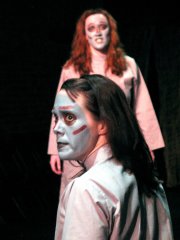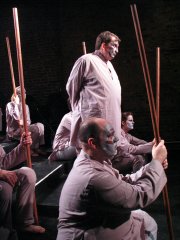
"Burial at Thebes" by Seamus Heaney: Two Views
by Ellen
W. Lytle
by Paulanne Simmons
It's A Wrap
 |
| Foreground: Jessica Crandall as Antigone. Behind: Louise Flory as Ismene. |
"The Burial at Thebes,"
Seamus Heaney's new translation of Sophocle's "Antigone"
directed by Alexander Harrington
Through February 11 at La MaMa E.T.C., 74A East Fourth St., NYC
Tickets $18; box office 212-475-7710
Reviewed by Ellen W. Lytle Feb. 6, 2007
Director Alexander Harrington and poet/playwright Seamus Heaney make a marvelous match in the current production at La MaMa. They take another of Sophocles' complicated family tragedies and simplify the story by focusing solely on Antigone's rebellious justification to give her brother, Polynieces, a decent burial and adding some colloquial speech, a pinch of humor and a narrating chorus.
The actor playing the fateful messenger definitely provides such deft wit and presence that when he brings the bad news about Polynieces' body being prepared for a burial, instead of left for carrion to pick at until there's nothing left to recognize, he risks a death sentence himself, unless he can produce the culprit. This of course would be Antigone setting the scene for her own injustice as well as that of her love, Creon's son, Haemon.
The entire cast, wrapped in gray/beige muslin togas and pants, who perform bare foot, except for Creon in sandals, also wear uniform faces drawn like masks with make-up, and along with the barren grayness of the stage, the focus stays perfectly where it belongs; with the monologues, the chorus dialogue and the precise movement of the actors using every inch of small stage as if they were, indeed, at Thebes in the space of a generous outdoors.
It’s a spectacle of simplicity, which is such a pleasure today after so much glitz and excessive staging. But Heaney is a poet who also eases in the message that Sophocles' Greece is an absolute metaphor for today’s U.S. government. The similarity between the rigid royalty from fourth century B.C. and the Bush regime is stunningly accurate, except for the fact that King Creon finally listens to reason and acquiesces his brutal assessment of Antigone and the will of his people, while our cabinet keeps on lying.
To me they wrap it up perfectly with the tragic parallel that Creon’s reversal of his commands unfortunately come too late but so does the Allied military action and both result in the inconsolable loss of life. Though in four hundred B.C. it was pretty much de rigeur. What’s today’s excuse… [Lytle]
A Familiar Tragedy
 |
| Frank Anderson as Creon, surrounded by members of the Chorus. |
''The Burial at Thebes''
Directed by Alexander Harrington
La MaMa etc.
74A East Fourth St. (First Floor Theatre)
Opened Jan. 25, 2007
Thurs. thru Sun. 8 p.m., Sun. matinee 2:30 p.m.
$18 (212) 475-7710
Closes Feb. 11, 2007
Reviewed by Paulanne Simmons Feb. 8, 2007
It's been over two thousand years since Sophocles wrote ''Antigone,'' but La MaMa's staging of ''The Burial at Thebes,'' a 21st century adaptation of the Greek classic, is every bit as up-to-date and pertinent as if it had been written yesterday.
The credit belongs, in part, to Irish playwright Seamus Heaney, who infuses the play with poetry. Thus Antigone (Jessica Crandall) dismisses the too little, too late assistance of her sister Ismene (Louise Flory) with the admonishment that ''You can't just pluck your honor from a tree you didn't plant.'' And Haemon (John McCarthy) warns his father, Creon (Frank Anderson) that ''The ones who are fullest of themselves are the emptiest.''
Heaney even gives the play a comic touch by turning the Guard (the excellent Raymond McAnally) into a country bumpkin whose practicality and lack of moral backbone is understandable in a man of his rank. However, these traits are not acceptable in a ruler like Creon, who, according to Heaney and the chorus, should know better.
Director Alexander Harrington also deserves credit for his compelling staging. As in his 1997 production of ''Agamemnon,'' Harrington reverses the stage, placing some members of the audience on the stage and bringing much of the action into the seating tiers. This has the advantage of allowing the audience to witness the tragedy unfolding in the same way as the chorus, which stands on the steps. But it has the disadvantage of putting the actors totally out of the line of vision of viewers who didn't get the right seats.
Harrington also reinforces the ritualistic elements of the play with movement (Claire Pavlich is the choreographer) and a score written by Carman Moore. The actors' faces are painted, perhaps in imitation of Greek theatrical masks. But the result is mostly a distraction that prevents the audience from seeing the actors' facial expressions.
''The Burial at Thebes'' was commissioned in 2004 as part of the centenary celebration of the Abbey Theatre and was inspired by the war in Iraq. By his own admission (in the Guardian, 2005), Heaney saw in George W. Bush ''a Creon figure…a law and order bossman trying to boss the nations of the world into uncritical agreement with his edicts.''
That may be so, but Anderson's Creon is far more reasonable and thoughtful than one suspect President Bush is, even on his best days. Unlike Bush, this Creon has a certain dignity, indeed a benevolence that somehow softens his stubborn refusal to listen to the sound advice of others.
If Anderson gives texture and depth to his character, Crandall turns Antigone into a one-dimensional heroine with no doubts, no self-recrimination and no fear. In other words, a boring stick figure. One can be sure the Greeks expected more.
''Burial at Thebes,'' as ''Antigone'' before it, explores issues that have remained unresolved throughout the millennia: the use and abuse of power, the virtue and limitations of loyalty, the demands of responsibility. But it is also a play about relationships: father to son, sibling to sibling, the ruler to the state and the citizens of that state.
Sometimes the feelings evoked by a relationship clash with abstract principles people have been taught to live by. When individuals are unable or unwilling to adapt to specific conditions problems arise. Twenty-five hundred years ago the Greeks thought this was the stuff of tragedy. It still is. [Simmons]
| lobby | search
| home | cue-to-cue |
discounts | welcome | film
| dance | reviews |
| museums | NYTW
mail | recordings | coupons |
publications | classified |
